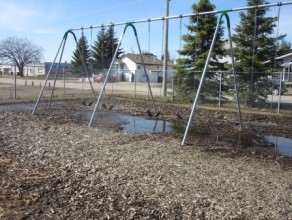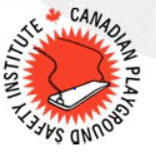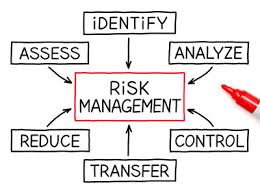
Learning Objective: To discuss the recommended inspection practices for Playgrounds after winter conditions.
The requirements/recommended practices for inspections of playgrounds follows CSA Z614 “Children’s Playspaces and Equipment Standards”. Compliance with this CSA standard will help to reduce injuries on playground equipment. This document will discuss the recommended practices for Playground Inspections before opening in the spring.
 Design & Operation
Design & Operation
- All Playgrounds should be installed according to the most current CSA standard.
- A “third party” detailed Playground Safety Audit should be in place on all equipment.
- Standard impact protection, sand, pea gravel, wood chips, rubber, etc. should be maintained at all times.
- Damaged equipment should be repaired or removed from play immediately to help prevent injury.
 Spring Time Inspection
Spring Time Inspection
- Have any changes taken place to the equipment over winter that could affect the integrity of the playground structures.
- Is all playground equipment in good condition with no damage or missing pieces?
- Is all impact protection materials maintained to appropriate depths to help minimize exposure to injury (Tilling or top up may be required after winter snow pack)?
- Check to make sure all standing water is drained as quickly as possible or device cordoned off until such time as this water can be drained.
- If needed, Cordon off equipment from use should repairs, standing water, or other damage be evident.
- Is appropriate signage provided and visible alerting patrons to current conditions?
Regular Inspection/Maintenance Schedule
- Daily/weekly: Visual inspection for broken glass, vandalism, animal droppings, damaged equipment, etc. Replenish or rake ground cover. This inspection should be conducted before students arrive in the morning (if a school) and can be performed by any staff member or a custodian. The inspection and any corrective action should be logged in a daily journal. (Appropriate maintenance department staff should be notified immediately if any concerns are noted. Have process in place, work order or communications system, documented inspections and follow up.)
- Monthly:This is a more detailed inspection and must be recorded on an appropriate equipment checklist form. This inspection should be conducted by a certified inspector. Any maintenance or repairs noted on the checklist should be acted upon immediately, and recorded when completed.
- Annually:This is a comprehensive audit of the playground site that should be conducted by a certified playground inspector. Contact your applicable department office or ourselves if needed. Annual Audits should be provided as per current CSA standards.


For additional information, contact:
Doug Taylor, CRM, CCPI
Managing Director, Risk Management Group
doug.taylor@suncorpvaluations.com

Learning Objective: To provide some suggestions on what to consider as part of your schools re-opening plans during and post the COVID-19 pandemic.
Many School Divisions are meeting to examine how they can safely re-open their schools now that the Governments and Provincial Health Authorities have given their approval. In discussions with many of you and information we’ve gathered from other areas throughout Canada and around the world, we thought it was timely to provide you some of the ideas being considered.
Ultimately, everyone wants to ensure our schools are safe for staff and students while at the same time providing an effective environment for students to learn. As such, balancing this will be the challenge that School Divisions will encounter as they navigate the various requirements.
Things to consider:
- Thorough cleaning of all schools prior to student’s arrival.
- Hand sanitizers located at all key entry points and common areas throughout school.
- Constant promotion of proper hand washing for all staff and students.
- Regular screening of students/staff for temperature, and COVID-19 related symptoms. If symptoms present, Isolate until such time as they can be picked up by a parent/care giver.
- Staggered arrival/departure times. Different grades starting and being dismissed at different times.
- Staff/students splitting their instructional days where a portion will be instructed in classrooms and a portion via home based learning.
- Implementing alternate days/weeks where students will attend school and learn from home.
- Smaller number of students on buses (supports the staggered start time’s scenario).
- Smaller number of students in classrooms to maintain required physical distancing of 2m.
- Process in place within hallways, stairs, and other common areas to ensure proper distancing is maintained, ie. one staircase designated for down only and one designated for students going up.
- More emphasis on distance learning. Some Divisions are considering certain grades will be taught through distance learning programs versus in schools. This will provide some relief on the challenges associated with classroom loads in many schools.
- Re-purposing single use rooms such as libraries, cafeterias, gyms into multi-purpose areas where lessons can take place.
- Using outdoor learning when weather & systems permit. Use of sports field surrounding schools as outdoor classrooms.
- Looking to rent alternate facilities to use for instruction.
- Redrawing of school boundaries to take advantage of underused facilities.
- Availability of applicable PPE for staff and/or student use.
- Removal/decommissioning water fountains.
- Installation of Water Bottle filling stations.
- Restricting visitors to schools – applicable sign in/out sheets should now be mandatory in all schools.
- Parents restricted from entering schools during drop-off and pick-up times.
- Frequent cleaning of all common and high touch areas.
- Look at the merits of installing automated systems such as lights, and doors to limit contamination of high touch areas.
- Policies for to avoid sharing of school supplies, food, etc.
- Meal service – proper Provincial Food Safety training should be mandatory for all staff involved in this area including the use of PPE. How food is provided to students is also being reviewed – delivered to student versus buffet style lines. Ways to continue with meal programs in schools is critical for many of the students well being.
- Removal of microwaves from common areas, and classrooms; used only by Food Safety trained staff.
- Physical activities – sports like basketball, football, volleyball, baseball, etc. pose some unique challenges given the student is required to touch the ball, whereas sports such as soccer, lacrosse, golf, track events (without relay batons, javelin, shot put) and hockey are such where the participant doesn’t touch (skin contact) the ball/puck on a regular basis.
Flexibility:
- The need for flexibility in adapting to the temporary requirements is critical as we make our way through these challenging times.
- Now, more than ever, regular documented inspections should be provided and maintained for all areas within a school including the mandatory sign-in and sign-out logs for all staff and visitors.
Final Thoughts:
Throughout your planning process, there needs to be an ongoing analysis on primarily three areas when reviewing your re-opening plans:
- The physical – actual brick and mortar requirements. Reconfiguration of learning spaces, installation/removal of equipment, safety devices, etc. What are the technology requirements for laptops, internet connections, etc.? What are the transportation needs for our students?
- The Human element – the affects these plans will have on staff and students. Everything from staffing levels, the ability to work remotely to the mental challenges the reopening may have on staff and students will require continual monitoring and support.
- Financial Impact – Some of these changes will require significant capital expenditures. There should be open discussions with all stakeholders (internal and external) in order to the meet the needs.
While this information is specific for school divisions, these considerations could be applied anywhere.
For additional information, contact:
Doug Taylor, CRM, CCPI
Managing Director, Risk Management Group
doug.taylor@suncorpvaluations.com

Learning Objective: To discuss the dangers of mixing bleach with other cleaners.
The danger of making your own sanitizer can be significant and we thought it timely to send out an Inspection Tip to make sure everyone stays safe. As we navigate our way through the COVID-19 virus, we all understand the importance of maintaining a clean environment around us. Unfortunately, when a shortage of product occurs, people may resort to making their own sanitizing products that may result in dangers they never knew existed. In this document, we will discuss some of the dangers of attempting to mix bleach with various cleaners found around the home.
Chlorine Bleach
Sodium Hypochlorite is the active ingredient in chlorine bleach, it is found in household bleach and many other disinfectants. Sodium hypochlorite reacts with ammonia, drain cleaners, and other acids. Many household products state that they contain bleach on the label.
Mixing Bleach with Acids
When chlorine bleach is mixed with an acid, chlorine gas is given off. Chlorine gas and water combine to make hydrochloric acid.
Chlorine gas exposure, even at low levels and for short periods, usually irritates the mucous membranes (eyes, throat, and nose). This can cause coughing and breathing problems, burning and watery eyes, and a runny nose. Higher levels of exposure can cause chest pain, more severe breathing difficulties, vomiting, pneumonia, and fluid in the lungs. Very high levels can cause death.
Acid Products
Products containing acids include vinegar and some glass and window cleaners, automatic dishwasher detergents and rinses, toilet bowl cleaners, drain cleaners, rust removal products, and brick and concrete cleaners.
Mixing Bleach with Ammonia
When bleach is is mixed with ammonia, toxic gases called chloramines are produced. Exposure to chloramine gases can cause the following symptoms:
- Coughing
- Nausea
- Shortness of breath
- Watery eyes
- Chest pain
- Irritation to the throat, nose, and eyes
- Wheezing
- Pneumonia and fluid in the lungs
Ammonia Products
In addition to using ammonia as a cleaning product, ammonia can be found in some glass and window cleaners, interior and exterior paints, and in urine (use caution when cleaning litter boxes, diaper pails, or toilet bowls).
Mixing Bleach with Other Cleaning Products
Bleach also reacts with some oven cleaners, hydrogen peroxide, and some insecticides. Pool chemicals frequently contain calcium hypochlorite or sodium hypochlorite and should not be mixed with other cleaning products.
Some Common Household Products to avoid mixing

1. Bleach + vinegar = chlorine gas.
This can lead to coughing, breathing problems, burning and watery eyes.
Chlorine gas and water also combine to make hydrochloric acid.
2. Bleach + ammonia = chloramine.
This can cause shortness of breath and chest pain.
3. Bleach + rubbing alcohol = chloroform.
This is highly toxic.
4. Hydrogen peroxide + vinegar = per acetic/peroxyacetic acid.
This can be highly corrosive.
More Resources
- Product labels usually have a toll-free telephone number that you can call to learn more about the product you have purchased. Most manufacturers also have web sites with product information
- If you or someone you know has been exposed to a chemical mixture and is experiencing symptoms of illness, contact a health care provider or emergency response service (911).
For additional information, contact:
Doug Taylor, CRM, CCPI
Managing Director, Risk Management Group
doug.taylor@suncorpvaluations.com

In our July 2019 blog we looked at the advantages of a comprehensive Loss Control Report in a hard market. Given the current market conditions for insurance placement, we thought it would be prudent to offer further considerations that may assist you in placing residential / condominium risk. As we see from the market reaction, losses incurred within this market segment have outpaced many other occupancies; accordingly, we endorse a proactive approach.
Like any other organization, the onus for managing the risk associated with these types of complexes falls on the applicable Boards / Councils and by extension, agents such as property managers and ultimately the unit owners. The steps outlined below should assist in mitigating and alleviating the type and severity of loss:
1. A clearly defined Policies and Procedures document should be drafted and held in place for all unit owners. The document should outline where the responsibilities lie for the Condo Board / Council and owners / tenants. This document is generally outside of the organization’s bylaws, allowing it to be easily amended as needed. The following are our suggested items for this document:
a. All work in any unit or within the building should ONLY be done by a licensed contractor (i.e. certified trades such as plumbers, electricians, carpenters, etc., with proof of insurance provided), as defined by the Board / Council.
b. Procedures should be in place to ensure all units are inspected on a regular basis when a tenant / unit owner will be away for an extended period of time.
c. Dishwashers and washing machines should only be run while the unit is occupied.
d. A clearly defined Emergency Response Plan should be developed and in place for each complex within the property. The Plan should have clear instruction / training provided for on-site residents / staff regarding what to do in the event of an emergency.
e. Insurance requirements with pre-determined coverage limits should be in place for all unit owners / tenants, that clearly define what coverage should be in place.
2. A regular maintenance and inspection program should be implemented and documented throughout all areas of the property. Items to consider are as follows:
a. All gutters should be cleaned on a semi-annual basis (or more frequently if the property is surrounded by trees), to ensure they are flowing as required.
b. All downspouts should have extensions of at least six feet to ensure that water does not pool around the foundation of the building.
c. All mechanical systems (boilers, furnaces, water heaters, make-up air units, air conditioning units, sprinkler systems, etc.) are inspected on an annual basis, with components replaced as required.
d. All walking surfaces should be in good condition and not subject to potential trips and falls. Snow removal, sanding and salting should be done within 24 hours in winter months.
e. Ensure all windows, doors and roofs are in good overall condition, with repairs to flashing, caulking around windows, doors, etc. completed as required and documented.
f. Areas subject to snow load should be cleared as required.
g. All shut-off valves should be exercised (fully closed and reopened) at least once per year, to ensure they function as required.
h. All drains should be inspected, cleaned out and tested on a regular basis, to ensure there are no obstructions and they are draining as required.
i. All rubber water hoses on washing machines / dishwashers should be replaced with a metal braided hose to prevent accidental rupture.
j. All drains from washing machines should be secured in place to the domestic drain to prevent accidental water discharge during the drain cycle.
k. Backflow prevention devices should be installed in all sewer drains.
l. Isolation valves should be provided on each floor for the main water system.
m. Water sensor alarms should be provided in all areas where water leaks could occur.
n. Water heaters should be replaced at a minimum every ten (10) years.
Having a comprehensive Risk Assessment Report on your facility is a huge advantage for brokers to successfully market their client’s business to the industry. A third party, arm’s length report provides an objective overview of the insured premises: the hazards associated in the operation and the controls in place to manage these hazards, so that the underwriter has a clear picture of the risk they are preparing to take on.
If you have any questions on the various Risk Management and Valuation services we can provide, please contact one of our offices and we would be happy to help.

In our last blog post we talked about the importance of understanding your client’s exposure, values, risk management strategies and policy wording – especially when dealing with a hard market in the insurance industry like we are today.
READ: The Property Insurance Market Has Hardened
Challenges Facing Brokers and Clients Is Significant
With Insurance Companies tightening their underwriting requirements, increasing premiums and deductibles, and reducing limits, the challenges facing brokers and their clients is significant. Placing a client’s business – regardless of whether they have had a claim or not – can be a daunting task, and where you might have had 2 or 3 insurance companies on a risk before, today we are seeing upwards of a dozen companies now involved.
Advantages of Comprehensive Risk Assessment Reports
Having a comprehensive Risk Assessment report on your client’s operation is a huge advantage for brokers to successfully market their client’s business to the industry. This third party, arm’s length report provides an objective overview of your client’s operation – the hazards associated in the operation and the controls in place to manage these hazards – so that the underwriter has an excellent picture of the risk, they are preparing to take on.

Understanding Different Types of Clients
While many insurance companies today will categorize clients based on, the type of business they operate, this “broad brush” approach can affect many clients with limited or no loss experience. The residential/condominium market is a good example of an industry that has been hit hard given the high number of losses in this type of occupancy. However, in saying this, not all clients will fall under this category. Understanding what separates these clients from the rest is the message that needs to get across.
Solid Risk Management More Critical Than Ever
The insurance market is still well capitalized, however, insurance companies are becoming more selective to write only good quality risks. Solid risk management strategies are now more than ever a critical component for managing your client’s business. A comprehensive Risk Assessment report will provide you and your client with an invaluable tool to assist in mitigating losses, while at the same time providing you the leverage to differentiate your client’s business from the masses during insurance renewals or placement.
Our Risk Management & Valuation Services
If you have any questions on the various Risk Management and Valuation services we can provide, please contact one of our offices, we would be happy to help.
Contact Suncorp Now
 Design & Operation
Design & Operation Spring Time Inspection
Spring Time Inspection








